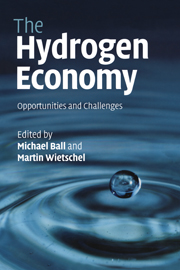Book contents
- Frontmatter
- Contents
- List of main contributors
- Preface
- Acknowledgements
- List of abbreviations
- 1 Scope of the book
- 2 Why hydrogen?
- 3 Non-renewable energy resources: fossil fuels – supply and future availability
- 4 Non-renewable energy resources: nuclear fuels
- 5 Assessment of the potentials for renewable energy sources
- 6 Carbon capture and storage
- 7 Energy-chain analysis of hydrogen and its competing alternative fuels for transport
- 8 Hydrogen today
- 9 Fundamental properties of hydrogen
- 10 Hydrogen production
- 11 Hydrogen storage
- 12 Hydrogen distribution
- 13 Key role of fuel cells
- 14 Hydrogen-infrastructure build-up in Europe
- 15 Building a hydrogen infrastructure in the USA
- 16 Hydrogen and the electricity sector
- 17 Hydrogen corridors
- 18 Macroeconomic impacts of hydrogen
- 19 Sustainable transport visions: the role of hydrogen and fuel-cell vehicle technologies
- 20 Energy-efficient solutions needed – paving the way for hydrogen
- 21 The future of hydrogen – opportunities and challenges
- Further reading
- Index
- References
20 - Energy-efficient solutions needed – paving the way for hydrogen
Published online by Cambridge University Press: 22 January 2010
- Frontmatter
- Contents
- List of main contributors
- Preface
- Acknowledgements
- List of abbreviations
- 1 Scope of the book
- 2 Why hydrogen?
- 3 Non-renewable energy resources: fossil fuels – supply and future availability
- 4 Non-renewable energy resources: nuclear fuels
- 5 Assessment of the potentials for renewable energy sources
- 6 Carbon capture and storage
- 7 Energy-chain analysis of hydrogen and its competing alternative fuels for transport
- 8 Hydrogen today
- 9 Fundamental properties of hydrogen
- 10 Hydrogen production
- 11 Hydrogen storage
- 12 Hydrogen distribution
- 13 Key role of fuel cells
- 14 Hydrogen-infrastructure build-up in Europe
- 15 Building a hydrogen infrastructure in the USA
- 16 Hydrogen and the electricity sector
- 17 Hydrogen corridors
- 18 Macroeconomic impacts of hydrogen
- 19 Sustainable transport visions: the role of hydrogen and fuel-cell vehicle technologies
- 20 Energy-efficient solutions needed – paving the way for hydrogen
- 21 The future of hydrogen – opportunities and challenges
- Further reading
- Index
- References
Summary
Primary and final energy demand per capita or per gross domestic product (GDP) is quite high, which reflects the large losses at each level of energy conversion and use. This section stresses the fact that energy use will have to become much more efficient before hydrogen as a final energy carrier becomes attractive, given its relatively high generation cost. The option of energy and material efficiency is often forgotten, owing to a traditionally supply-oriented energy policy and the fact that efficient solutions of material end-energy use have so far remained without powerful lobbying institutions. The world of energy and material efficiency – which represents the most profitable option for many decades in this century – has to be tackled before hydrogen stands a chance of becoming a major final energy carrier and finds its place within a sustainable energy system in industrialised countries.
Present energy losses – wasteful traditions and obstacles to the use of hydrogen
In 2003, almost 450 000 PJ of global primary energy demand delivered around 295 000 PJ of final energy to customers, resulting in an estimated 141 000 PJ of useful energy after conversion in end-use devices. Thus, around 300 000 PJ – or two-thirds – of primary energy are presently lost during energy conversion, e.g., in power plants, refineries, kilns, boilers, combustion engines and electrical motors, mostly as low- and medium-temperature heat. These losses also include the small share of losses from the transmission, transformation and distribution of grid-based energies (see Fig. 20.1).
- Type
- Chapter
- Information
- The Hydrogen EconomyOpportunities and Challenges, pp. 599 - 612Publisher: Cambridge University PressPrint publication year: 2009
References
- 4
- Cited by



